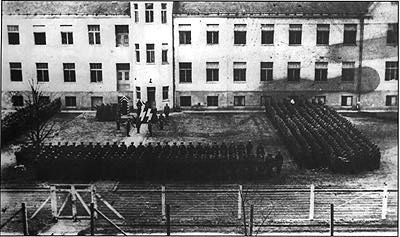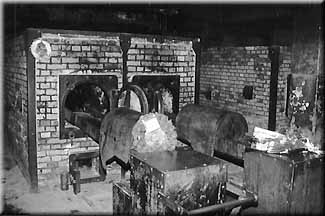|
|
|
|
|
|
|
A gathering of the SS guards. |
|
| Auschwitz has been a sign of the holocaust for many years. | |
| "Forever let this place be a cry of despair and a warning to humanity, where the Nazis murdered about one and a half million men, women, and children, mainly Jews from various countries of Europe" | |
|
Auschwitz was established on May 27, 1940. It is located outside the town Oswiecim. |
|
| As soon as the Jews arrived they were taken off the train and told to form two lines Women and children in one, men in the other. The ones thought able to work were separated from the others. The ones not able to work were sent directly to the gas chambers. The prisoners that came to the camp were not aware that all their valuables could be taken. Only 25% were selected to work on arrival. | |
|
"My first and foremost task will be the annihilation of the Jews." |
|
|
Adolf Hitler |
|
| The Jews wore a star of David to identify them. Their hair was taken from them and made into "hair cloth". | |
| Roll Call: Above the main gate Work leads to Freedom was written. In front of the roll call booths public executions were held. The roll calls often took hours until everyone was accounted for. If anyone fell during the roll calls they were gassed. | |
| 6,000 volts of electricity ran through the wires of the fences that surrounded the camp. Eight miles of canals also surrounded the camp. | |
| On April 16, 1947 Rudolf Hoss was hung on the gallows. He lived just minutes away from this place. | |
| The crematorium could incinerate 350 bodies per day. The leather taken from the shoes of the victims was used to make things for the German army's uniforms. | |
| When the Nazis first took the people to the camps they told them they were going to settle in a new country. | |
|
A Typical Day in Auschwitz |
|
|
|
| This is one of the crematories used to incinerate the Jews. It could incinerate 350 bodies per day. | |
|
Women and Babies in the camp The pregnant women were sent to the gas chambers immediately. Even the few babies that were born were killed by the SS doctors. In 1943 Aryan babies were allowed to live. They received tattoos just like the adults. If the baby lived two months the mother was forced to give up her baby or be gassed. Sometimes the babies were killed by rats. It was prohibited to drink the water in the camp because it was contaminated, but some children drank it and died. The life span for women in the camp was about twice as short as the men's.
|
|
|
Uprisings On October 23, 1943 a woman with an unknown identity pulled a pistol out of the hands of an SS guard and then shot two others. On October 7, 1944 prisoners blew up the gas chamber of crematorium IV. Then in November 1944, the SS blew up the crematories and extermination plants. Jewish leaders in the free world wanted the Allies to bomb Auschwitz. This could have stopped the mass murders. On April 7, 1944 a well known escape took place. Two young Jews named Alfred Wetzler and Walter Rosenberg wrote a report that was smuggled into the free world. Some of the escapees kept diaries. They hid them in the ground and they were discovered after the war. Auschwitz was evacuated from January 17 until the 19, 1945. The closer the Red Army came the more desperate the SS became to try to get rid of the evidence. The prisoners not evacuated from the camps were taken by the Red Army on January 27, 1945. When the Red Army arrived at the camp there were about 5,000 sick and dying still there. Only about 667 prisoners in all escaped from Auschwitz. 270 of those were recaptured and killed.
|
|
| Brady
Watson
Rossville Jr. High - 7th Grade 2002 Holocaust Project |

